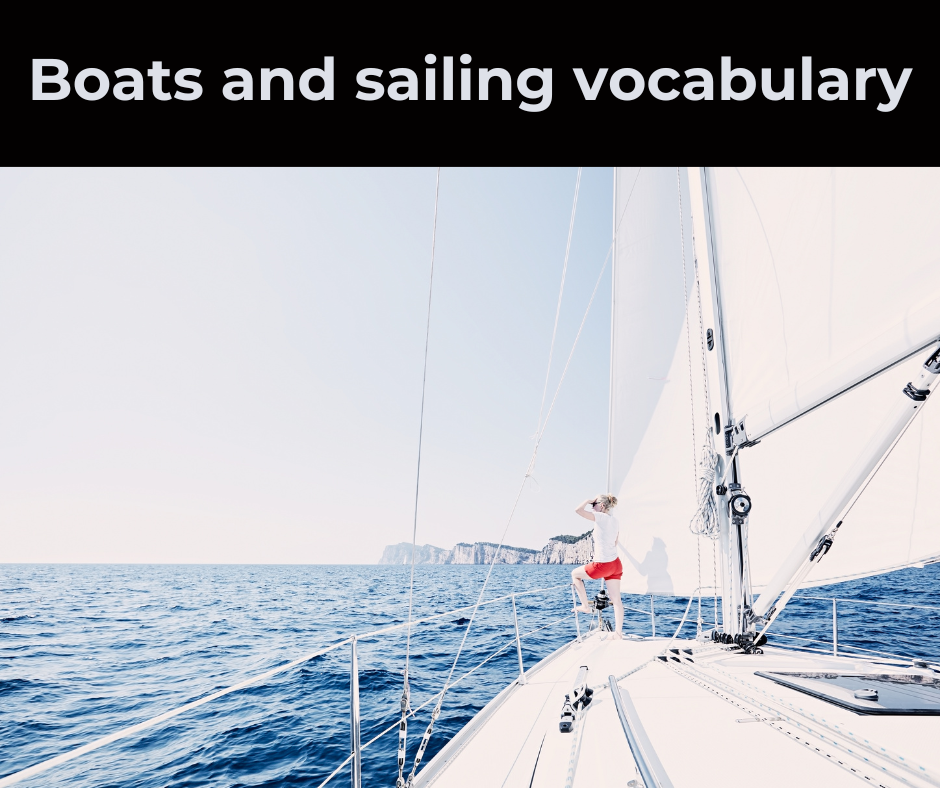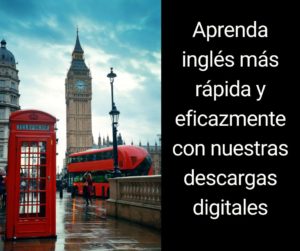
In today’s podcast, you’ll learn some boat and sailing vocabulary so that next time you’re out on the ocean waves you’ll know what everyone is talking about in English!
“Ahoy there, matey!”
Voice message from Andres from Colombia
English Expressions from The Sea: https://inglespodcast.com/150
Different Means of Transport: From Bicycles to High-Speed Trains https://inglespodcast.com/527 (ferry, cruise ship. rowing boat, yacht etc)
Pirates and Pirate vocabulary: https://inglespodcast.com/419
Have you ever been sailing?
Vocabulary
To weigh anchor, anchors aweigh! (when the anchor clears the sea bed and a ship can set sail)
Sail – large pieces of cloth that catch the wind and propel a ship/ to travel on water
Jib – a small sail in front of the mainsail.
“I like the cut of your jib”
“Originally meaning that a person was recognized by the shape of his (her) nose. It has now come to indicate what someone thinks of a person’s appearance or demeanour: ‘I like the cut of his jib’, ‘I like his attitude.’ The term originated among sailors of the mid-18th century, when the nationality of warships sighted at sea could be accurately determined by the shape of their jib long before the national flag could be seen. For instance, French jibs were cut much shorter on the luff than English ones, giving a distinctly more acute angle in the clew”
Batten down the hatches – to prepare for a storm or rough weather.
Bow – the front part of a ship.
Stern – the rear part of a ship.
Aff – Towards the back of a ship (like saying the back of a house).
Starboard – the right side of a ship (when facing forward).
Port – the left side of a ship (when facing forward).
The word “posh” is said to come from the acronym POSH – port out, starboard home, the most expensive transatlantic liner tickets. Although, this has never been confirmed as true.
Mast – tall, upright pole that supports the sails of a ship.
Boom – a horizontal pole extending from the mast to which the bottom of the sail is attached.
“Watch your head when the boom swings!”
Rudder – a flat piece, usually of wood or metal, attached vertically to the stern and used for steering.
Helm – the steering wheel of a ship. “To take the helm”
Keel – the main structural member of a ship, running lengthwise along its bottom.
Hull – the main body of a ship.
Deck – the flat surface covering the hull of a boat.
“All hands on deck”
Cabin – a room on a ship where the crew or passengers live. (sometimes called a berth)
Galley – a ship’s kitchen.
Tacking – a sailing maneuver to change direction by turning the bow into the wind.
Port – a place where ships can dock and load or unload cargo.
Buoy – floating marker used to guide or warn boats.
To moor – to secure a ship to a dock or buoy.
Knot – a unit of speed used in navigation, equal to one nautical mile per hour.
Nautical Mile – a unit of distance used in navigation, equal to 1.852 kilometers.
Types of vessels
Rowing boat – a small boat rowed with two oars
Sail/Sailing boat – a boat with a sail that uses the power of the wind
Motorboat – a small boat powered by a motor engine
Speedboat – a motorboat designed for high speed
Ferry – a boat/ship that transports passengers on short journeys
Liner – a large, luxurious ship used on a regular line (e.g. The Titanic)
Cargo ship – a ship that transports goods
Container ship – a very large cargo ship that transports containers
Tanker – a large ship that transports oil
Cruise ship – a very large passenger ship for cruises, stopping in various ports
Warship – a ship equipped with weapons for naval battle
Aircraft carrier – a very large warship that transports aircraft
(Rubber) dinghy – a small boat used on rivers or for rescue at sea
Lifeboat – a boat used at sea to rescue people
What’s the difference between a quay, pier and dock?
Quay (pronunciation: key): A quay is a platform constructed along the shore, typically made of concrete, stone, or metal, where ships can dock parallel to the shore for loading and unloading cargo.
Pier: A pier is a long, narrow structure that extends from the shore into the water. It is usually built on piles and can be used for docking ships, fishing, or leisure activities.
Dock: The term “dock” can refer to different things depending on the context. In British English, it often means an enclosed area of water in a port used for loading, unloading, repairing, or building ships. In American English, it can also refer to the area between or next to a man-made structure where boats are moored.
What’s the difference between a port, a harbour, a bay, a gulf, a cove and a fjord?
Harbour: a sheltered area where ships can drop anchor safely. Harbours can be natural or man-made.
Port: a dedicated trade or ship handling area inside a harbour. It’s a place for loading and unloading cargo and passengers. It’s used for commercial activity and often has rail and road connections inland.
Bay: a broad inlet of the sea where the land curves inwards.
Gulf: a large bay.
Cove: a small bay (or costal inlet)
Fjord: a Norwegian word which means ‘long narrow body or water’. It’s formed by moving glaciers.
Discussion
Where in the world would you like to go sailing the most?
Do you get seasick?
Sailing yacht or motorboat? Why?
If you built your own sailboat, what would you name it?
…and now it’s your turn to practise your English. Are you a keen sailor? Do you have a boat? Why not tell us about it? You can use the vocabulary in this podcast to describe it.
Send us a voice message. https://www.speakpipe.com/inglespodcast
Send us an email with a comment or question to [email protected] or [email protected]
If you’re a Spanish speaker and you want to improve your English with free and paid resources, visit the mansioningles website at mansioningles.com and for paid products you can browse the online store at https://store.mansioningles.net/
Thank you to our Patreon supporters. Join our Patreon program and you get instant access to the transcriptions of this podcast and live Zoom chats so that you can practice speaking. https://www.patreon.com/inglespodcast
Welcome to our new Patreon supporters who have joined us this month:
Victoria Gonzalez
Jose A. Garcia
Alicia Criado
Volmir Chiapetti
José A Ortiz
Gicela
In next week’s episode: When to use the prepositions FOR and TO
If you enjoyed this podcast, please tell your friends.
The music in this podcast is by Pitx. The track is called ‘See You Later’





Such a handy and helpful site, and the most priceless podcats, thanks a lot Craig, by the way, I cherish on your british accent, will recommend this to all my mates who are planning to take the exam too.
Thank you, Dayana. Thanks for listening and for recommending us.